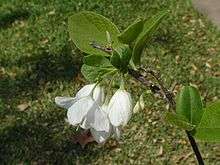Halesia diptera
Halesia diptera, the two-wing silverbell or two-winged snowdrop tree, is a species in the family Styracaceae, native to the southeastern United States from South Carolina and Florida west to eastern Texas.[2] It is cultivated as an ornamental tree.
| Two-wing silverbell | |
|---|---|
 | |
| Scientific classification | |
| Kingdom: | Plantae |
| Clade: | Tracheophytes |
| Clade: | Angiosperms |
| Clade: | Eudicots |
| Clade: | Asterids |
| Order: | Ericales |
| Family: | Styracaceae |
| Genus: | Halesia |
| Species: | H. diptera |
| Binomial name | |
| Halesia diptera | |
Description
It is a large shrub or small tree reaching 4–8 m tall. The leaves are deciduous, 6–12 cm long and 4–7 cm broad. The flowers are white, 2-2.5 cm long, produced in clusters of 3–6 together. The fruit is a dry (non-fleshy) drupe with two wings down the sides; this distinguishes it from the other species of Halesia, which have four wings on the fruit.[3]
Wildlife, including squirrels, eat the unripe sour green fruit.[4]
Varieties
There are two varieties:[2]
- Halesia diptera var. diptera
- Halesia diptera var. magniflora R.K.Godfrey
Mature tree in flower
gollark: H.
gollark: ++magic reload_ext irc_link
gollark: I don't know. Some are from IRC channels in the vaguely linuxy community.
gollark: (and in a separate directory)
gollark: They're shipped with it still but rot13ed.
References
- IUCN SSC Global Tree Specialist Group.; Botanic Gardens Conservation International (BGCI). (2020). "Halesia diptera". IUCN Red List of Threatened Species. 2020: e.T152857713A152905527. doi:10.2305/IUCN.UK.2020-1.RLTS.T152857713A152905527.en. Retrieved 6 May 2020.
- "Halesia diptera". Germplasm Resources Information Network (GRIN). Agricultural Research Service (ARS), United States Department of Agriculture (USDA). Retrieved 21 January 2018.
- Huxley, A., ed. (1992). New RHS Dictionary of Gardening. Macmillan ISBN 0-333-47494-5.
- Little, Elbert L. (1980). The Audubon Society Field Guide to North American Trees: Eastern Region. New York: Knopf. p. 639. ISBN 0-394-50760-6.
| Wikimedia Commons has media related to Halesia diptera. |
This article is issued from Wikipedia. The text is licensed under Creative Commons - Attribution - Sharealike. Additional terms may apply for the media files.
